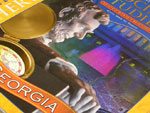The History of History
Question

Can you give me a brief history of U.S. history, considered as a professional field?
Answer
What we think of as professional history began in the 1880s, when historians began to get jobs in colleges and universities and also tried to develop a "scientific" approach to the subject. From there, the history of U.S. history tends to be shaped into four stages, which are shaped by the big ideas that shaped historical thinking at the time.
The founding generation of professional historians is generally remembered as being not much different in attitude from the amateur or "gentlemen" historians that preceded them. But they did spend a significant amount of their time gathering and analyzing documents about political and military leaders and activities, and writing about them in exacting (many would say excruciating) detail.
These historians were followed by a generation of "progressive historians" (starting around 1910). Characterized by historians such as Charles Beard, these progressive historians drew on new techniques and questions from other social science fields, and also tended to take a more critical view of the American past as they tried to engage the past from the perspective of contemporary concerns.
The progressive historians were displaced after World War II by a generation of "consensus" historians, who oriented their work within prevailing American ideas at the time—particularly notions of post-New Deal liberalism and ideas about American exceptionalism. They are remembered as not pushing questions into uncomfortable or difficult areas of the American past, and papering over some of the deep social conflicts in the nation's past.
Starting in the mid-1960s a new wave of historical opinion emerged, particularly among the younger baby boom historians entering the profession. They placed a greater emphasis on expanding the range of subjects included in history (most visibly women, minorities, and working people), and in the process, tended to highlight conflicts and differences between social groups. At the same time, they developed new techniques to get at these historical actors—using computer technologies to sift through quantitative data and looking at old documents with new questions in mind.
These stages are useful for understanding the large trends in the development of professional history over the past 130 years, but like any effort to tie up the past in neat little packages, it is also a bit too simplistic. In every period there were plenty of historians who ran against the prevailing types, either because they were experimenting with different methods, thinking about different subjects, or just generally brought a contrarian view to their work.
Read without imposing any particular historiographical spin, the most significant change was the broadening and deepening of historical work, as growing numbers of historians took up new and different subjects and used an ever wider array of tools and techniques to pull the past into the present. The present state of professional history seems more in line with that history, since no "big idea" seems to be animating work on U.S. history today. But there are currently more historians publishing more historical work (in print and online) than ever before.
For more information
Higham, John. History: Professional Scholarship in America. Baltimore, MD: Johns Hopkins University Press, 1989.
Novick, Peter. That Noble Dream: The 'Objectivity Question' and the American Historical Profession. New York: Cambridge University Press, 1988.
Tyrrell, Ian. Historians in Public: The Practice of American History, 1890-1970. Chicago: University of Chicago Press, 2005.
